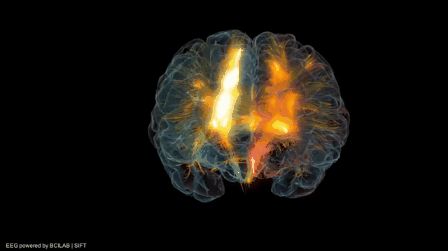
Whatsapp +(593) 0984110192
El 80% logra una mejora significativa inclusive en los pacientes que no les funcionan los antidepresivos
Transcranial Magnetic Stimulation is an updated and innovative therapy that is used successfully in prestigious centers around the world, it is focused on the recovery of the mental and cognitive functions of patients with neuro-psychiatric problems that have not responded correctly to medicines or that needs help in focal neuronal functioning through cerebral neuromodulation.
The team uses energy created by magnetic fields for cortical neurons connected with neural networks, favoring the balance in focal neuronal functioning that will result in the recovery of brain function.

What is Transcranial Magnetic Stimulation (TMS) and how does it work?
Transcranial Magnetic Stimulation (TMS) is a technique for the treatment of depression and other psychiatric and neurological disorders, which acts directly stimulating the brain. Transcranial Magnetic Stimulation (TMS) activates certain specific parts of the brain and their interconnected neural networks by using a coil that creates a magnetic field that in turn produces electrical energy. The energy of this magnetic field is transferred to the brain when the device is applied to a person's head. The magnetic stimulation goes through the scalp and the skull bone reaching the cerebral cortex, this activation of the brain does not produce pain and is performed without the need of sedation or anesthesia.
When is Transcranial Magnetic Stimulation (EMT) used in depression?
Currently, antidepressant medications and psychotherapy are the first line treatments for depressive disorders. These pharmacological treatments however, in addition to having their side effects do not work in all patients. In these cases, Transcranial Magnetic Stimulation has its precise indication, you can even work together to increase the effectiveness of antidepressant medications or psychotherapy (without having to increase the doses or add another antidepressant drug). Other indications are patients who do not wish to enter antidepressant therapy and its side effects, or who can not tolerate these medications, or patients with this disease during pregnancy.
What other diseases are treated with EMT?
Every time the international scientific community finds new indications of use for Transcranial Magnetic Stimulation, among them we find more patients with depressive illness refractory to drugs (without adequate response to drugs), it is used for the treatment of invalidating migraines that are those that occur with such a high frequency or intensity that prevent the person suffering from it from having a normal productive life, is also being used to treat the negative symptoms of schizophrenia and cases of dependence on alcohol, tobacco and drugs. There is a lot of research that supports its use in patients with Parkinson's disease and Dementia. Other indications are in Attention Deficit Disorders, the presence of Tinnitus or noise in the ears, for the recovery of patients with Severe Cranial Traumas and in the neurorehabilitation of cerebrovascular accidents in general and in those with language impairment in particular in the that associated with physical and language therapies, a clear and faster recovery of lost or altered functions is evidenced. There are several studies of the use of this technique in patients diagnosed with fibromyalgia that are accompanied by invalidating pain, achieving a blockade of the painful response at the level of the central nervous system, significantly improving the quality of life of these patients. Finally we can also use this technique in completely healthy patients in which we want to improve memory and mental agility.
Who prescribes and administers Transcranial Magnetic Stimulation?
The EMT can be prescribed by a psychiatrist or neurologist, anyway all patients before starting therapy will be assessed by one of our doctors of NeuroInnovation, non-invasive brain stimulation experts, to draw up a treatment plan and clinical monitoring specific according to each particular case and the specific diagnosis of each one.
In all sessions of Transcranial Magnetic Stimulation will be present as a doctor of our company and we also have the help of technicians who monitor the proper functioning of the equipment and are ready to assist the patient throughout the procedure.

What are the side effects of Transcranial Magnetic Stimulation?
EMT is well tolerated and associated with few side effects. The most common side effect, which is reported in about half of patients treated with EMT is a mild headache. If necessary, regular analgesics are prescribed, before or after the EMT sessions for the treatment of this discomfort.
Approximately one third of patients may experience painful sensations on the scalp with EMT pulses. Over time, the scalp becomes less sensitive to the pounding sensation of the magnetic pulses and the treatment does not cause discomfort as it tends to decrease over the course of treatment, although adjustments can be made immediately during the procedure both in the position of the coil as in the stimulation equipment to reduce this discomfort.
The EMT team produces a noise and because of this the patient is offered plugs for both ears which decrease this discomfort.
EMT is definitely not associated with many of the side effects caused by antidepressant medications, such as gastrointestinal upset, dry mouth, sexual dysfunction, weight gain or sedation.
It is important to note that EMT is a very safe procedure, that's why it has been approved by the FDA (Food Drug Administration) of the United States of America.
Does Transcranial Magnetic Stimulation interrupt other areas of brain functioning or does my personality change?
One of the benefits of EMT, in relation to other treatments for depression and other psychiatric disorders, is the precision that is achieved in the region of the brain that you want to stimulate.
EMT allows medical experts in neurostimulation to direct the stimulus to very specific parts of the brain, leaving other areas outside the area of stimulation. EMT does not lead to memory problems or other alterations in thinking. It does not change a person's personality, however, when patients experience relief from the symptoms of depression, their mental and memory agility improve significantly.
Do I have to be hospitalized for a Transcranial Magnetic Stimulation treatment?
EMT does not require sedation or general anesthesia, so patients are fully awake and aware during treatment, being able to return to their usual activities immediately after the procedure.
Who cannot receive therapy with Transcranial Magnetic Stimulation?
Patients with some type of non-removable metal in the head (with the exception of braces or dental fillings). Failure to comply with this rule can cause the object to become hot, move and cause a malfunction or cause some kind of focal injury. The following list is the metal implants that can prevent a patient from receiving EMT:
• The aneurysm clips at the brain level.
• Stens in the neck or in the brain.
• Stimulators implanted in the brain as used in Parkinson's Disease.
• Cardiac pacemakers or implantable cardioverter defibrillator.
• Electrodes to monitor brain activity.
• Metallic implants in ears and eyes.
• Bullet fragments in or near the head.
• Facial tattoos with metallic objects or sensitive to magnetism.
• Other metal devices or objects implanted in or near the head.
How is EMT currently developing in the USA and Europe?
These techniques have been used in research since the 80s to better understand the functioning of the nervous system and, more recently, have become part of the therapeutic arsenal to treat, among others, diseases such as depression, migraines, dependencies, chronic pain such as that associated with fibromyalgia, the rehabilitation of cerebral vascular disease and the sequelae of cranial trauma.
The list of universities, hospitals and first level institutes that use these techniques within the United States and Europe is very large, here we show you references of international centers that will be able to recognize
• Harvard University, Boston
• Johns Hopkins Hospital, Baltimore
• Mayo Clinic, Arizona, Minnesota, Florida
• University of Oxford, England
• Guttman Institute, Spain
• Insituto de Neuroestimulación, Spain.
How can I get treatment with Transcranial Magnetic Stimulation?
Before scheduling for treatment, you must first be evaluated by one of our EMT expert team doctors to determine if the EMT would be appropriate for you.
Please feel free to contact Neuroinnovation if you need any further information.
Videos
Documentos
Enlaces

Hemos seleccionado una excelente cartera de videos, noticias y artículos de distintas partes del mundo para que obtenga la mejor y mayor información posible.
Estimulación Magnética Transcraneal (EMT)
Transcranial Magnetic Stimulation (TMS)
Uso de la Estimulación Magnética Transcraneal en Parkinson
Tratamiento de Parkinson
Neuroestimulación Ecuador
Estimulación Magnética Transcraneal
Demencia Senil ETM
Neuroinnovation Ecuador
Testimonio Demencia Senil
Testimonio Madre Trastorno del Espectro Autista
Trastorno del Espectro Autista
Testimonio Madre Neuroinnovation Ecuador, Trastorno del Espectro Autista
Trastorno Obsesivo Compulisvo
ETM Ecuador
Neuroestimulación Magnética Trascraneal en el Trastorno Obsesivo Compulsivo
Trastorno del Espectro Autista
Testimonio Madre
Neuroinnovation Ecuador
Estimulación Magnética Transcraneal
Trastorno del Espectro Autista
Testimonio Madre
Estimulación Magnética Transcraneal
Entrevista Programa Día a Día - Teleamazonas
Manipular el cerebro
Programa REDES España
Punset descubre, junto a Álvaro Pascual-Leone, neurólogo del Harvard Medical School, el funcionamiento de la "estimulación magnética transcraneal", un método para modificar la actividad de las vías neurales sin la administración de fármacos ni la utilización de cirugía.Si se puede alterar determinados circuitos neuronales, ¿se podrá también llegar a modificar el comportamiento o mejorar nuestras habilidades mentales? ¿Es posible manipular el cerebro para modificar nuestra forma de ser o acabar de una vez por todas con las enfermedades mentales?
Tennessee TMS Center
What is it and how does it work?
Explicación gráfica creada por el TMS Center para explicar el funcionamiento de EMT en los pacientes
TMS Therapy NYC-Treatment for Depression
TMS en USA
Descripcion de como esta la EMT cambiando la vida de pacientes en USA
Adolescent depression and TMS
de Tonic TV
This video is part of the Tonic series, produced with the assistance of NPS MedicineWise. Tonic is an ABC News24 magazine-style program that relies on the latest evidence and advice from world-leading health experts to inform viewers and help them to live a healthier life.
TMS en medios de Brasil
Este video es una compilación de reportages realizads en 2014 de los siguientes medios:
Jornal da Gazeta (TV Gazeta)
Bom Dia Brasil (TV Globo)
Programa "Bem Estar" (TV Globo)
Jornal Nacional (TV Globo)
Euronews
TEDx
TEDxAdelaide - Michelle McDonnell - TMS
Can magnets be used to treat epilepsy?
For over 25 years, magnets have been used to stimulate the brain to investigate how nerve cells are connected in the brain. In many instances people with diseases affecting the brain such as stroke, epilepsy, dystonia and depression have been studied, to work out which pathways are affected. Michelle McDonnell explored how we might treat these conditions using transcranial magnetic stimulation (TMS) and if TMS treatments really work...
Transcranial Magnetic Stimulation Improves Memory
Transcranial Magnetic Stimulation: A Cure for Depression?
Demostración visual científica del proceso EMT, utilizada en el show de Dr.Oz.
Artículo de Prestigiosa Revista Actas Españolas de Psiquiatría
Link sobre estudio realizado de EMT
Revista de origen español donde el editorial busca la calidad de los artículos que se publican, su originalidad y sobre todo su interés científico. El proceso de selección de los artículos a publicar es exhaustivo y se lleva a cabo con el máximo cuidado, teniendo como meta siempre la calidad de la revista, avalada por su prestigio a lo largo de su historia durante más de 70 años.
EMT: fundamentos y potencial de la modulación de redes neurales específicas
A. Pascual Leone y J.M. Tormos Muñoz
Alvaro Pascual-Leone, MD, PhD, is Professor of Neurology at Harvard Medical School; Director of the Berenson-Allen Center for Noninvasive Brain Stimulation
La EMT ofrece una oportunidad única para la caracterización y modulación de redes neurales en sujetos normales y enfermos con distintas patologías neuropsiquiátricas.
Doctors Treat Depression With Brain Magnets
REVISTA TIME
Click para ver







